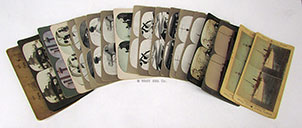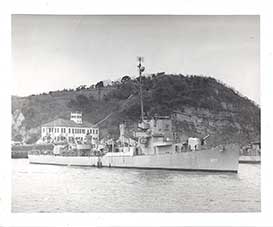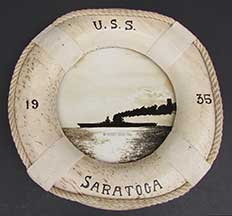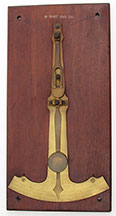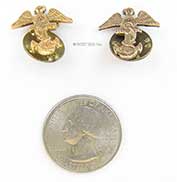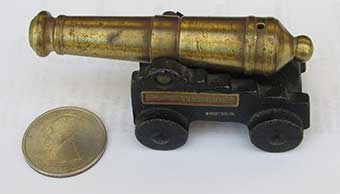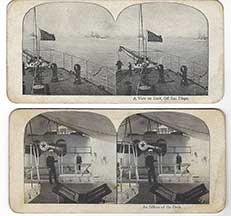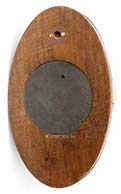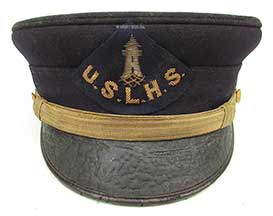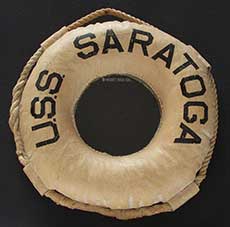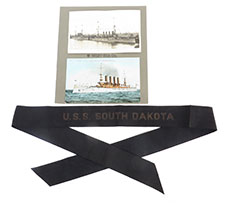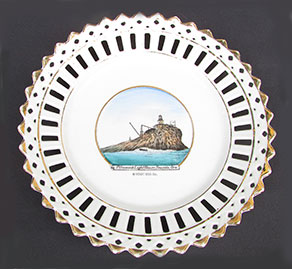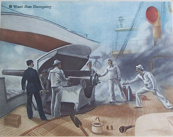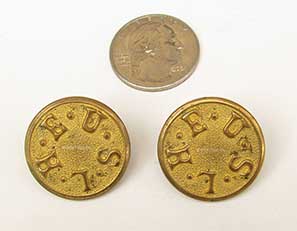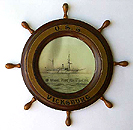NAVY, USLHS, USLSS & MILITARY
Catalog Page 5
When no price is shown, use
Click on photos for larger images.
Click
![]() for ordering details.
for ordering details.
|
5.37 EARLY U.S. NAVY DECK CLOCK. Awesome, pre-World War II ships clock with black enameled dial reading “MARK I DECK CLOCK, U.S. NAVY (N) 1064, 1939” and further marked “Made By Seth Thomas In U.S.A.” at the bottom. It features bold Arabic numbers with a minute chapter swept by white enameled spade hands. The subsidiary seconds bit is below the “12,” divided by single seconds marked by 10’s. The dial is protected by its original convex crystal made of an early form polymer. The extremely hefty solid bronze case weighs an amazing 16 pounds! The clock hinges forward on its mounting plate secured with a wing nut on the right. It opens to expose the winding and setting features on the back of the case protected by a rotating dust cover. The clock case seats on the back plate which retains its original rubber gasket for an air tight seal. The back plate is actually two parts, sandwiched together with an internal rubber cushion held by three screws to minimize shock when the ship’s guns were fired. 8 ½ inches in diameter and 4 inches deep with a lovely high polish rose bronze finish. This clock has just been professionally serviced by our AWI (American Watch Makers Institute) certified technician and is in tip top running and cosmetic condition. Complete with winding key. Originally priced $1295. Now 40% OFF for the Holidays! 779 |
|
PERSPECTIVE
|
DIAL
|
BACK
|
|
OPEN
|
BACK PLATE
|
|
5.36 SHIP’s PLAQUE.
Solid cast brass U.S. Navy unit plaque from the “USS
ALCOR (AK 259)” as boldly cast in high
relief. This charming plaque depicts a seahorse
delivering a cargo crate to the deck of a battleship.
The scene is encompassed by a rope border. It measures
6 ¼ inches in diameter, ½ inch thick and weighs 3
pounds. Outstanding original condition. 49
|
|
PERSPECTIVE
|
 |
|
5.35 IDENTIFIED SAILOR’s
KNIFE. Very scarce, genuine Civil War era
U.S. NAVY knife identified as having belonged to “Josiah
Dixon” on board the “USS FLORIDA” as
engraved on the bone grip. This unusual relic from the
Civil War originally had 3 fold-out blades and a cork
screw. One of the blades is missing. The other
two and the folding cork screw are still in tact. A
portion of the bone grip adjacent to the missing blade also
appears to have been cut out. The base of the blunted “beak”
main blade is marked “UTLEA__FFIELD,” near the
bolster, indicating the blade was made in Sheffield,
England. This is consistent with the fact that
Sheffield produced the highest quality steel in the world at
the time. Early American Naval knives were nearly
always of Sheffield manufacture. The reverse side of
the blade is deeply impressed “US NAVY.”
All metal surfaces show spotting and some minor
rust. Extended, this knife measures 5 ¼
inches long and 3 inches long closed. Condition is “fairly
good” noting the exceptions above. A true museum
quality Civil War Navy relic with the sailor's name, his
ship and U.S. Navy-marked. Priced accordingly.
395
|
|
CLOSED
|
REVERSE
|
DETAIL
|
OPEN
|
US NAVY
|
|
5.34 U.S. NAVY PISTOL.
Authentic early American small arm made for the U.S. Navy by
the Aston or Middleton Arms works in Middletown,
Connecticut. This genuine side arm is an unmarked
example of the Navy’s model 1842, caliber 54
percussion pistol which first saw combat in the Mexican War
of 1845. This cap and ball pistol has a large smooth
bore of the finest steel with a brass sight on the tip of
the barrel. The steel hammer engages the nippled
chamber with a positive fit and locks in the half cock
(safe) and full cock positions. It fires with a
strong, tight action as properly actuated by the trigger
with minimal force. The stock is made of a rich, dense
wood, which is fully brass-bound including the butt, trigger
guard and stock attachment to the barrel. This muzzle
loader is complete with its unique built-in ram rod which
pivots into position for loading and swings out of the way
under the barrel into the stock when not in use. 14
inches long with a outside barrel diameter of ¾
inches. The steel parts of this pistol show moderate “spotting”
(otherwise “very light” pitting). The
brass surfaces are clean with a nice age patina. The
wooden stock is very sound with no splits or cracks, but it
does exhibit some gouges on the left side above the
trigger. In excellent condition this firearm sells for
over $3,000.
995 Colonel Robert H. Rankin, USMC (Ret), “Small Arms of the Sea Services,” 1972, Norman E. Flayderman & Co., New Milford, Connecticut, pictures this weapon on page 97. He writes, “H. Aston & Co., Navy Percussion Pistol, Model 1842 Caliber .54. This arm is 14 inches long overall. It weighs two pounds, twelve ounces. All brass furniture. An anchor is stamped on the barrel. In front of the hammer appear “US” and “H. ASTON & CO” in two lines. To the rear of the hammer in three lines, appear “MIDDtn,” “CONN” and 1854.” This model was also made by I. N. Johnson of Middleton, Connecticut. Johnson at one time was a partner in the firm of H. Aston & Co.” |
|
5.31 PHOTOGRAPH of FAMOUS
BATTLESHIP. Original old black and white
photograph of the famous American dreadnought, the USS
UTAH (BB-31) taken shortly after her launching in
1909. The proud, brand spanking new battle wagon is
shown at anchor with tender boats alongside, even a small
sailing ketch! The distinctive early-style “cage”
masts are prominent in the photo as are her massive twin
turreted 12 inch guns. The image measure 6
½ by 8 ½ inches sight and is in nearly perfect
original condition. 29 |
|
5.32 PERIOD WWII SHIP PHOTO.
Original large format black and white image of the Buckley
Class Destroyer Escort USS GEORGE (DE-697) as
depicted moored off of the Customs House in the Philippines
in 1945. This clear image shows good detail of the
man-o-war’s deck and armament along with crew members
on the foc’sle. This valiant veteran of the
Pacific campaign exhibits remarkable upkeep after all she
has been through! The glossy 7 1/8 by 9 inch image is
in perfect original condition.
10 |
|
5.27 U.S. LIGHTHOUSE SERVICE FLASK
MEASURE. Extremely rare, highly sought after,
19th century example of a lighthouse keeper’s
equipment used in the course of duties maintaining his
sentinel. This authentic veteran of that noble service
is made entirely of brass and bears the stamped mark on the
front of the spout “U.S. LIGHTHOUSE ESTABLISHMENT.”
It is further marked on the bottom “U.S. LIGHTHOUSE
(ESTABLISHMENT)” the latter being faintly
impressed. The circular spun brass body has a rolled,
reinforced handle riveted to it for pouring. The body
of the measure is scribed with lines starting at the bottom,
marked “1 PTS.” upward to “3 QRTS”
for a total of 6 graduations. The interior is tinned
to resist corrosion and exhibits a dark gray patina.
This large flask measures 10 3/4 inches high by 6 ¾
inches in diameter at the base and 8 ¼ inches wide
overall. Condition is excellent and original with a
nice age patina, noting just a few very minor dents of no
consequence. A lovely, genuine lighthouse object from
the 1800’s. 1969 In 1910, the Board was dissolved in favor of a civilian run “Lighthouse Service.” It is uncertain as to when the exact time line was drawn between the existence of the U.S. Lighthouse Establishment and the U.S. Lighthouse Service. Both terms for the agency seemed to have been used interchangeably in the second half of the 19th century. In 1939 the U.S. Lighthouse Service itself was formally disbanded and merged with the U.S. Coast Guard. |
|
REVERSE
|
HANDLE DETAIL
|
INTERIOR
|
|
5.24 FLARE GUN WITH U.S.L.H. SERVICE
PROVENANCE. Genuine early 1900’s
American flare pistol manufactured by the “The
Remington Arms – Union Metallic Cartridge Co.,
Inc. MARK III, Remington Bridgeport Works –
Bridgeport . Connecticut . U.S.A.” as struck on the
top of the steel barrel. This handsome firearm has an
all brass receiver with rich walnut grips. The
percussion hammer and trigger are cross hatched steel.
The barrel pivots forward for loading and is locked into
position by a sliding bar with knurled screw head on the
left. Internally, the bottom of the receiver is serial
numbered “08011.” The 10 gauge single shot
barrel measures 9 inches long. The gun measures 12
½ inches long overall. Excellent original
condition with virtually no spotting or pitting on the
barrel. The brass and wood components are
perfect. 495 |
|
REVERSE
|
OPEN
|
DETAIL
|
|
PERSPECTIVE
|
BARREL
|
|
SIDE
|
HOOD
|
HELMSMAN VIEW
|
MAGNET ASSEMBLY |
|
COMPASS
|
LAMP
|
COMPONENTS
|
MAKER
|
|
5.17 EARLY BOS’N PIPE WITH LANYARD. Genuine World War II vintage or earlier Navy boatswain’s whistle made of solid sterling silver. It consists of a large round bowl attached to a gradually tapering pipe which terminates in a flared mouthpiece. The pipe is affixed to a reinforced shank or "keel" which is impressed "STERLING" on the side. A suspension loop is the point of attachment for the fancily macraméd lanyard which was worn around the sailor's neck as part of his dress uniform. This bos'n call was crafted by a skilled silversmith with telling mortise joint on the bottom of the shank and a seam on the bottom of the finely tapered tube. It measures 5 1/2 inches in length and is in perfect condition, producing a loud, shrill tone. The intricate sailor-made lanyard with Turk’s head knot measures 28 inches long fully extended. 295 HISTORY of the BOATSWAIN'S CALL. The Call has its beginnings in the days of the English Crusades, 1248 A.D., as a method of alerting troops to arms. Documented in 1485 A.D., the call was used as an honored badge of rank, then being worn by the Lord High Admiral of England. Undoubtedly it was worn because it was used as a method of passing orders, and therefore signified authority. When the Lord High Admiral, Sir Edward Howard, was killed in action off Brest in 1513 while commanding French Galleys, a "Whistle of Honour" was presented to him posthumously by the Queen of France. From about that time onward the call was no longer used as a badge of rank, reverting to its original use as a method of passing orders only. About 1671 the name Call was well established, lasting to the present day. In the U.S. Navy the call is often referred to as a Boatswain's Pipe. |
|
5.19 LIGHTSHIP/YACHT RACE BOOKENDS. A matching pair of heavy solid bronze bookends cast in high relief showing the San Francisco Lightship in starboard profile. These handsome bookends have the added appeal of being yacht race trophies. The top edges bear a rope twist border under which is the embossed inscription “AEOLIAN YACHT CLUB ALAMEDA CHAMBER OF COMMERCE.” Below the inscriptions are detailed high relief casting of the lightship with the inscriptions along the hull reading “LIGHTSHIP RACE 1953” and “LIGHTSHIP RACE 1956” respectively. The first is further engraved “DIV.9 2ND SONJA” and the second “DVISION 9 WON BY DEBUTANTE.” These bookends are identical except for the race inscriptions. They both have a lovely statuary bronze age patina and measure 8 3/8 inches wide, 5 ¼ inches high and 2 ¾ inches deep. Outstanding original condition. 395/pr |
|
5.11 U.S. NAVY BOAT CLOCK.
Very scarce and highly collectible, early 1900's
boat clock made for the U.S. Navy by the Waltham Clock
Company as marked on the blackened dial and impressed on the
back of the solid brass case. This rare clock has a
diminutive 3 1/2 inch dial featuring raised brass Arabic
numerals, minute chapter, silver spade hands and an unusual
seconds bit at the 12 o'clock position which entirely
obscures that numeral! The original silvered brass
reflector ring is present. The dial is signed
"WALTHAM" above the center arbor and "U.S. NAVY BOAT CLOCK"
with the hand-engraved inscription "[N]4121" below.
It contains its very high grade, all brass jeweled movement
comparable to the output of those companies competing for
Government contracts during World War I-- namely Chelsea and
Seth Thomas. This example by Waltham is much more scarce.
The heavy case measures 5 1/2 inches wide and is 2 1/2
inches deep. The back is prominently stamped “WALTHAM
-.- CLOCK CO.” Unpolished original condition and
an excellent time keeper in lovely original cosmetic
condition. Truly a rarity amongst Navy clocks! Circa
1915. Bargain priced.
985 |
|
5.14 EARLY NAVY DECK CLOCK. Very finest quality ship’s clock made for the U.S. Navy by the venerable Seth Thomas company as marked in gold at the bottom of the dial, “MADE BY SETH THOMAS IN U.S.A.” This historic Naval relic dates to the First World War. The black enamel dial is boldly marked “U.S. NAVY DECK CLOCK No 1” below the center arbor, and it is hand-engraved with the Navy serial number “N3505” just below the winding arbor. It features large gold Arabic numerals and a minute chapter ring swept by silvered spade hands. A subsidiary seconds bit below the “12” indicates single seconds marked by 10’s. Above it is the Fast/Slow adjustment with precision markings. The jeweled all brass movement is a thing of beauty and quality. It is entirely gold washed and the balance cock is decoratively-engraved in the time honored traditional manner. The top plate is signed in Victorian script, “Seth Thomas, THOMASTON, CONN.” It is housed in its original heavy solid brass case with classic flared screw-on bezel retaining the original old wavy glass. It measures 7 ¾ inches in diameter overall. This clock is in fabulous original condition with no flaws whatsoever and keeps perfect time! A very special old functional Navy relic! Complete with period winding key. 695 |
|
5. 10 NAVY CAPTAIN’s CUP and SUACER. Genuine World War II vintage coffee cup and saucer from the mess of a captain commanding a capital ship! The distinctive four star commissioning pennant is indicative of an afloat command of a major warship. This fine, hard-fired china is marked “Shenango China, Newcastle, PA” on the cup and “C.P. CO. Syracuse -China-” on the saucer. Both bear the unique commissioning pennant emblem. Outstanding, flawless condition. Rare! 95 A similar item is offered at http://www.thepirateslair.com for $109. |
|
DETAIL
|
|
5.06 BOATSWAIN'S PIPE. Authentic World War II vintage or earlier U.S. Navy boatswain's whistle made of solid sterling silver. This genuine "call" consists of a large round bowl attached to a gradually tapering pipe which terminates in a flared mouthpiece. The pipe is affixed to a reinforced shank or "keel" which is impressed "STERLING" on the side. A suspension loop is affixed for attachment of a macraméd lanyard which would have been worn around the sailor's neck as part of his dress uniform. This bos'n call was crafted by a skilled silversmith with a telling mortise joint on the bottom of the shank. It measures exactly 5 1/2 inches in length and is in perfect condition, producing a loud, shrill tone. 195
The Call has its beginnings in the days of the English Crusades, 1248 A.D., as a method of alerting troops to arms. Documented in 1485 A.D., the call was used as an honored badge of rank, then being worn by the Lord High Admiral of England. Undoubtedly it was worn because it was used as a method of passing orders, and therefore signified authority. When the Lord High Admiral, Sir Edward Howard, was killed in action off Brest in 1513 while commanding French Galleys, a "Whistle of Honour" was presented to him posthumously by the Queen of France. From about that time onward the call was no longer used as a badge of rank, reverting to its original use as a method of passing orders only. About 1671 the name Call was well established, lasting to the present day. In the U.S. Navy the call is often referred to as a Boatswain's Pipe. |
|
REVERSE
|
STERLING
|
|
IN BOX OPEN
|
BOX OPEN
|
WATCH
|
MOVEMENT
|
CASE
|
|
5.98 WORLD WAR II NAVY INSIGNIA. Handsome, World War II era petty officer’s shoulder badge denoting a First Class Storekeeper. This authentic sleeve patch is machine and hand stitches using real gold and silver thread on a heavy black felt backing. 6 ¼ inches high by 4 inches wide. Outstanding original condition. 29 |
|
5.94 IDENTIFIED SAILOR HAT. Very scarce early 1900’s seaman’s hat from the famous World War I British battleship, “HMS BARHAM” as indicated on the silk hat ribbon in bold gold letters. This bowler style straw hat was professionally made with the rim exhibiting a finely sewn tan cloth edge. The top bears a beautifully hand-embroidered compass rose in gold thread. The interior liner is also hand-sewn. 12 inches long by 11 inches wide. Amazing original condition for such a delicate item, considering it is just short of being 100 years old! 449 The Queen Elizabeth class British battleship HMS BARNHAM (pennant number 04) was laid down in February 1913, launched October 31, 1914 and commissioned October 19, 1915. She had a length of 643 feet and displaced 33,000 tons. Her main armament was eight 15 inch guns. Her crew numbered 1,150. On May 31st and June 1st, BARHAM participated in the famous Battle of Jutland off the coast of Denmark. The ensuing battle between the heavily armored and heavily gunned vessels of the Royal Navy and the Imperial German Navy is widely regarded by Naval historians as the final classic battle between surface combatants. BARNHAM fired 337 shells and received 5 hits during that action. This hat is from that era. In the intervening period between world wars BARNHAM was extensively modernized. At the outset of World War II she operated in the Atlantic and Mediterranean, sustaining damage from a German submarine torpedo attack in December 1939 while operating in the North Sea. The ship again saw action on September 25, 1940 when she engaged the French Battleship RICHELIEU, which struck her with a 380mm shell off the coast of Senegal. Returning to the Mediterranean, the ill-fated ship took part in the Battle of Cape Mattapan in March, and incurred bomb damage off Crete in May. On April 21, 1941 BARHAM attacked Tripoli harbor in company of battleships WARSPRITE and VALIANT and the cruiser GLOUCESTER. On November 25, 1941, while screening an Allied offensive on Italian convoys, BARHAM was struck by 3 torpedoes fired in rapid succession from German submarine U-331. The brutal attack caused the ship’s magazines to explode, whereupon she quickly capsized to port and sank taking two thirds crew of her crew with her. News of the sinking was not made public in Britain until January of 1942. Incredibly, the instant of BARHAM’s sinking was captured by an overlying British aircraft. Subsequently the film was used in several movies and war documentaries. |
|
TOP
|
INSIDE
|
SHIP
|
EXPLOSION
|
|
5.91 U.S. NAVY DECK CLOCK. Genuine World War I vintage clock made for the U.S. Navy by the venerable Seth Thomas Clock Company as marked on the blackened brass dial, “U.S. NAVY DECK CLOCK No. 3 MADE BY SETH THOMAS IN U.S.A.” This handsome, very hefty ship’s clock has a 5 ½ inch dial with Arabic numerals, minute chapter, spade hands and inset single seconds bit marked in 10’s under the “12.” The double wind arbors serve to run the massive solid brass “Number 10” Seth Thomas movement for 8 days. Complete with original silvered reflector ring. The movement has just been overhauled by a professional clock repairman and is in tip top running condition. The classic flared ship’s clock bezel is threaded and screws on and off the heavy brass case with a watertight seal. The lovely case, with rich original patina, measures 7 ¾ inches wide on the mounting flange, is 3 ¼ inches deep and weighs a hefty 9 pounds! The original dial bears the hand-engraved Navy number “N2272,” and is in near perfect while still showing its age. Complete with winding key. Circa 1918 or earlier. 795 |
|
DIAL
|
BACK
|
PERSPECTIVE
|
|
5.89 HISTORICAL BOOK. Nathan Miller, “The U.S. NAVY, An Illustrated History,” 1977, United States Naval Institute Press and the American Heritage Publishing Co., New York. Large format, 403 pages exclusive of notes and index, hard cloth cover with dust jacket. Here is the exciting, beautifully illustrated chronicle of a fledgling group of rag tag ships in the 1770’s which grew into the strongest navy in the world by the 1940’s! Mr. Miller discusses American Naval involvement in the Revolutionary War, War of 1812, the century of exploration, Barbary pirates, the Civil War, China Station, the Spanish-American War, World War I, World War II, Korea, Vietnam, and the atomic Navy. Each reach into history is richly illustrated in color and black and white with detailed captions. Easy to read, captivating and fact filled from cover to cover. The book itself is in “as new” condition. The dust jacket is worn. 49 |
|
PLATE 1
|
PLATE 2
|
PLATE 3
|
PLATE 4
|
|
5.87 U. S. NAVY COMPASS. Genuine high quality, very heavy World War II vintage liquid compass made for the Navy by “LIONEL N.Y. U.S.A.” as marked on the card flanking the fleur-de-lis at North. This original ship’s magnetic steering compass is boldly marked around the edge “U.S. NAVY BU SHIPS N1917 1942.” The perforated white enamel brass card is marked with the Cardinal and intercardinal points of the compass and is calibrated in single degrees from 0-360 on the periphery. The solid bronze compass bowl is housed in its original pivoting gimbal 9 ¾ inches in diameter and 10 ¾ inches across the mounting lugs. The compass itself measures 8 ½ inches in diameter with the card 7 inches across. Excellent original condition. The compass is still extremely lively and accurate and there is no bubble in the fluid. 349 |
|
CARD
|
PERSPECTIVE
|
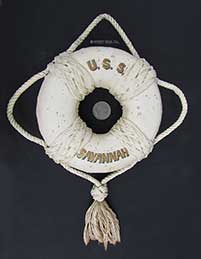 |
|
5.85 OFFICER’s SWORD BELT. World War II vintage U.S. Navy commissioned officer’s sword belt. This handsome all leather belt with brass fittings is of very sturdy construction. The gilded brass buckle depicts an American eagle perched atop an anchor surrounded by 13 stars and a rope border, encircled by acanthus leaves. The heavy brass clasp is also decorated with floral designs in relief. This adjustable belt has 2 belt loops and a secondary 6-position adjustable buckle. There is an added reinforcement at the rear of the belt and another reinforcement on the officer’s left side where the sword was hung. The belt is double stitched its entire length and is in outstanding original condition with no cracks and virtually no wear. The all important buckle is perfect. 99 Similar vintage belts in poorer condition are being offered on eBay with a Buy It Now price of $125. |
|
5.54 EARLY COAST GUARD PATCH. Pre-World
War II patch for the United States Coast Guard Auxiliary as
designated by a shield surrounding the string “USCG”
over a large “A” with 3 large horizontal bars
below. All are done in very heavy gold braid hand-stitched
to a black wool background with heavy cloth reinforcement on
the back. 2 3/8 by 3 ½ inches. Excellent original
condition showing good age.
29 |
|
|
|
5.70 WARDROOM TABLE CLOTH. Genuine World War II vintage cotton table cloth from the officers’ mess of a capital U.S. Navy fighting ship. This heavy duty white cotton cloth has machined-embroidered emblems of an eagle and shield atop perched atop an anchor surrounded by the words “UNITED STATES OF AMERICA DEPARTMENT OF THE NAVY” on both ends. The entire cloth bears numerous stars and stripes, with the periphery surrounded by braided rope designs. The cloth measures 11 feet 10 inches long by 5 feet 8 inches wide. It is in simply outstanding original condition with no wear, tears, holes, rips or stains and has just been professionally cleaned and pressed. Surprisingly heavy. A Navy rarity! 295 Because of the low contrast exhibited by the embroidery, we are unable to provide an adequate image of its fine detail. However we absolutely guarantee the quality and execution of this exceptional relic. |
 |
|
DETAIL |
 |
|
5.74 COAST
GUARD COMMEMORATIVE. Early commemorative photograph in a
ship's wheel frame identifying the "U.S.C.G.C.
MORRIS." The original, hand-tinted black and white photo
shows the Coast Guard Cutter MORRIS underway from
port with several crewmen on deck and the coastline in the
background. The glazed wooden frame is sculpted in the form
of a classic ship's wheel and the lettering is hand painted.
On the reverse is written "1928 J.E. Pallerin, Eng. Off."
along with (presumably) the address label of the last owner
in "Alameda, Calif." The overall condition of this handsome
display is outstanding, noting that there are 2 minor losses
of wood on the reverse of the frame which do not
affect the presentation at all when displayed. 12 inches in
diameter. Early U.S. Coast Guard relics are rare and highly
sought after.
595
|
|
5.63 HISTORIC NAVAL ENSIGN. Genuine pre-World War I American flag made of linen with 48 applied stars and sewn stripes. The hoist end canvas is marked “Bull Dog Bunting, Dettras Flag Products, Best By Test” with the maker’s logo. This flag measures 9 feet long by 55 inches wide and is in generally good condition with only a few small holes, one 2 ½ inch “L”-shaped tear (mended) and minor loss to the tip of one star. 395 Faintly penned on the canvas is the inscription reading, “DONATED TO MEXICAN… BY CARL ROWE US NAVY Retired. Pleasant Memories of Mexico-Veracruz, Brazil, Uruguay …on USS Chester…” On the morning of April 21, 1914, warships from the U.S.
Atlantic Fleet commanded by Rear Admiral Frank Fletcher made
preparation to seize the waterfront of Veracruz, Mexico in
response to the “Tampico Affair.” 500
Marines and 285 armed sailors from the Battleships
FLORIDA (BB-30) and UTAH (BB-31) began
landing operations. As whaleboats plowed through surf
toward the main wharf, a large crowd of Mexican and American
citizens gathered to watch the spectacle. The Americans
encountered no resistance as they debarked their whaleboats,
formed into ranks and marched towards town. This initial
show of force prompted the retreat of Mexican forces under
General Gustavo Mass. In the face of that retreat,
Mexican Commodore Manuel Azueta encouraged cadets of the
Veracruz Naval Academy to take up defending the port.
They were joined by about 50 Mexican Army soldiers who
stayed behind and a handful of stalwart Veracruzian
citizens. USS CHESTER (CL-1) was launched by the Bath Iron Works, Bath, Maine on June 26, 1907 and was commissioned April 25, 1908. In 1910 CHESTER joined in a special South American cruise commemorating the 300th anniversary of the founding of Buenos Aires, Argentina. On Aril 21, 1914 she participated in the landing at Veracruz, Mexico. Thereafter she transported refugees to Cuba, carried mail and stores to the squadron off Veracruz and performed various diplomatic missions until June 19. This flag purportedly was flown on CHESTER during the battle. |
|
|
|
5.62 LIGHTHOUSE and LIFESAVING SERVICE STEREO CARDS. A pair of genuine antique stereo cards with desirable subject matter. The first sepia-toned double image is identified as being that of the “Life-Saving Station, near Cliff House, San Francisco, California, U.S.A.” and is signed “Underwood & Underwood, Publishers.” The second is a chromolithographed original stereoscopic photograph entitled, “The Lighthouse Station at Hong Kong China” and is signed “Copyright . 1903 . Kawin . and . CO.” Both cards are in standard format and size, measuring 7 by 3 ½ inches. Condition of both is good, noting some surface soiling and importantly, no damage or losses. 99 for both |
|
5.47 U.S. NAVY CHINA. Authentic World War II vintage hard-fired porcelain china made for officers’ messes in the United States Navy. Also known as “Anchor China,” these examples vary in maker, but all are made to Navy specifications and are of the highest quality with no chips, cracks or scratches. a. Demitasse Set. Matching
cup and saucer for regular officers’ mess. Blue
rim with fouled anchor logo on both cup and saucer.
Saucer with maker’s mark on bottom. 5 inch
diameter.
29/set |
|
5.44 LIGHTHOUSE KEEPER’s BUTTONS. Full set of 8 large brass coat buttons for a keeper in the remote and inhospitable Northern Lighthouse Region. These detailed solid brass buttons are embossed in high relief with the image of a stone lighthouse, waves crashing at its base, flanked by buoys set on a backdrop of sea and sky. They are encircled by the inscription reading, “INSALUTEM OMNIUM (For The Safety of All) . NORTHERN LIGHTHOUSES .” Each button has a brass loop for attachment to the coat and is backmarked “Fermin, London.” These scarce buttons measure exactly one inch in diameter, and are in outstanding condition with much original gilding. 295/set of 8 The Northern Lighthouse Board was formed in 1786 as the
Commissioners of Northern Light Houses by Act of Parliament,
initially to oversee the construction and operation of four
Scottish lighthouses: Kinnaird Head; North Ronaldsay,
Scalpay; Outer Hebrides and Mull of Kintyre. The NLB
was a separate organization from the Trinity House, whose
Royal charter was established in 1514 by King Henry VIII of
England to oversee the construction and maintenance of
lighthouses in England, Wales and the Channel Islands. The Latin motto, “Insalutem Omnium” is also the motto of the Commissioners of Irish Lights. |
|
5.30 NAVY THERMOMETER. Genuine, World War II vintage or earlier, thermometer from the engineroom of a U.S. Navy ship. This handsome ship's instrument features a mercury-type thermometer affixed to a bold black scale reading in degrees Fahrenheit from 24 to 180 degrees in 2 degree increments. It is marked "Faht Temperature Scale" and is signed ""Moeller Co." Brooklyn, N.Y." The scale is housed under glass in a lovely solid bronze frame cast in relief "Trade AEM Mark" at the top. A hole has been drilled in the top for hanging, the back of which bears the serial number "6243." The protective steel probe was designed to fit into a pipe or container with a large threaded brass hex nut. The nut is prominently stamped with the Navy Inspector's mark consisting of an anchor flanked by the initials "US." 13 inches high by 2 3/8 inches wide. This identified Navy ship's relic is in outstanding original condition and registers the ambient temperature accurately. 169 |
|
5.28 ROYAL NAVY BOS'N CALL. Genuine, late 19th century or very early 1900's British Navy boatswain's whistle. This especially handsome example is constructed of nickel-brass and is embellished with floral designs surrounding a shield on both sides of the keel. The ovoid bowl is marked with the British broad arrow on both sides, and the stem is decorated with concentric reeding at two points along its length and at the mouthpiece. A small but heavy ring is connected to the keel for attaching the pipe to a lanyard which traditionally served as part of the sailor's uniform at that time. 4 1/2 inches long showing signs of age and careful use. 295 HISTORY of the BOATSWAIN'S CALL. The Call has its beginnings in the days of the English Crusades, 1248 A.D., as a method of alerting troops to arms. Documented in 1485 A.D., the call was used as an honored badge of rank, then being worn by the Lord High Admiral of England. Undoubtedly it was worn because it was used as a method of passing orders, and therefore signified authority. When the Lord High Admiral, Sir Edward Howard, was killed in action off Brest in 1513 while commanding French Galleys, a "Whistle of Honour" was presented to him posthumously by the Queen of France. From about that time onward the call was no longer used as a badge of rank, reverting to its original use as a method of passing orders only. About 1671 the name Call was well established, lasting to the present day. In the U.S. Navy the call is often referred to as a Boatswain's Pipe. |
|
5.42 SHORT SWORD. Genuine, mid-19th C. military short sword and scabbard of European origin. The solid cast brass grip with "bead" pommel is scalloped on 3 sides and fitted to the brass "figure S" guard which is marked "100.R.7.61." The high quality steel blade measures 19 inches long and bears a lustrous finish with some areas of pitting (shown). This sword is complete with its original leather scabbard which is identically marked on the brass throat. On the reverse is a stud for attachment to a frog and the bottom end has a brass tip. The leather on the scabbard has surface age cracks, but is very sound. The sword rates very good condition overall and has a total length of 25 inches. 495 |
|
5.18 LIGHTHOUSE CLOCK. Rare,
highly sought after early 1900's American clock made by the
Seth Thomas Clock Company for the United States Lighthouse
Service. This high quality clock features a silvered brass
dial with Arabic numerals and spade hands over a minute
chapter with subsidiary seconds bit below the "12." The dial
is prominently marked "U.S.L.H. SERVICE" above the winding
arbor and is further marked "Made by Seth Thomas in U.S.A."
on the bottom. The Fast/Slow lever adjustment is just below
the "12" and the silvered brass reflector ring is present.
This clock contains a diminutive Seth Thomas movement with
jeweled lever escapement and decorated platform. The all
brass movement measures only 2 5/8ths inches in diameter!
The backplate is signed below the winding arbor "Seth
Thomas, Thomaston, Conn." It is fitted in its original solid
brass "ship's clock" type case with flared screw-on bezel in
original nickel finish. The clock measures 5 1/2 inches in
diameter and 2 1/2 inches deep. Excellent original condition
throughout. This clock is a strong runner and a good time
keeper. Complete with winding key. Circa 1910.
|
|
5.08 CAPTAIN'S GIG PLAQUE. Interesting, probably unique, genuine World War II vintage plaque from the Captain's boat of a U.S. Navy capital ship. This engraved solid brass plaque is one-of-a-kind. It was obviously engraved on a one-time basis because it bears a few minor spacing errors. The plaque is entitled "Fuel Consumption Chart Captain's Gig Cap. 212 Gal Rate of Consumption". The chart indicates the number of gallons consumed at various speeds and rpm's. 4 3/4 by 6 inches. Outstanding original, "as removed" condition. 195 The Captain's boat or "Gig,"
through long tradition, was the best boat on board the ship.
Assigned to the top boat handler in the Boatswain's Mate
ranks, the Gig was an extension of the ship's identity,
prowess and pride. Great care was lavished on its upkeep and
presentability for all occasions. No doubt this plaque was
fabricated by a very industrious and conscientious
Boatswain's Mate who wanted to make certain his Captain
reached his destination on time with fuel to
spare! |
|
5.13 U.S. NAVY SHIP COMMEMORATIVE. Very nice late 19th or very early 20th century framed photograph of the U.S. Navy Gunboat VICKSBURG as identified in distinctive hand-painted script on the periphery. This handsome presentation consists of a hand-tinted silver plate print depicting the famous gunboat at anchor with a launch alongside the starboard accommodation ladder. The image is extremely detailed and bears scrutiny under high magnification. It is sealed under its original old wavy glass and measures 5 1/2 inches in diameter. Encircling this original photograph is a carved wooden frame in the form of a ship's wheel complete with spokes. The overall dimension is exactly one foot. Outstanding original condition in all respects. Such U.S. Navy commemoratives from the 19th century are rare! 349 The 204 foot steam brigantine USS VICKSBURG (Gunboat No. 11) was launched on December 5, 1896 by Bath Iron Works, Bath, Maine and commissioned on October 23, 1897. She was active in the Spanish-American War, patrolling the waters around Cuba where she captured 3 Spanish blockade runners. During the early 1900's VICKSBURG, was home ported at Mare Island, California and operated along the California coast with one patrol on China station. At the onset of World War I VICKSBURG patrolled the waters off of pro-German Mexico taking the schooner ALEXANDER AGASSIZ with five German prisoners as a prize of war. In May of 1921 VICKSBURG was transferred to the Coast Guard and renamed ALEXANDER HAMILTON for service as the training vessel for the U.S. Coast Guard Academy in new London, Connecticut until 1930. |
|
1.12 PAINTING. Luigi
Papaluca, Italian, early 20th century, gouache on paper
painting entitled "U.S.S. McDOUGAL" underway off Naples,
with Mt. Vesuvius in the distance. A pleasing, very colorful
ship's portrait skillfully executed by this well-listed
artist. All of the ship's details are beautifully rendered
with numerous crewmen visible on deck. The painting measures
16 by 24 1/2 inches sight and is signed lower right "L.
Papaluca." It is housed under glass in its original simple
wooden frame with brass-reinfoced corners measuring 17 by 26
inches. Circa 1940. Outstanding original
condition.
895 The second U.S. Navy ship to bear the name McDougal was laid down by the New York Shipbuilding Corp., Camden, N.J. on December 18, 1933, launched July 17, 1936 and commissioned as destroyer 358 on December 23rd that same year. USS McDOUGAL (DD-358) first operated in the
Pacific with Destroyer Squadron 9 out of San Diego,
California. In the Spring of 1941 McDOUGAL returned
to the Atlantic to escort the cruiser AUGUSTA with
President Franklin D. Roosevelt embarked for a meeting with
Prime Minister Winston Churchill in Newfoundland. On August
10, McDOUGAL transported FDR to and from the meeting
on the ill-fated British Battleship HMS PRINCE OF
WALES. |
|
|
|
15.51 CIVIL WAR SAILOR. Very fine cased tin type image of an American sailor during the Civil War. This eighth plate tin type depicts a very handsome young man posed in a studio setting in the typical "flat hat" of the era with a bos'n pipe lanyard prominent on his uniform. Encircling the oval image is a bright gilt patriotic metal border depicting eagles carrying American flags, cross rifles and swords, cannons and drums, all within an ornate foliate border. This in turn is encased under glass in a wooden leather covered case with hinged lid lined with velvet in a decorative floral pattern. The exterior of the leather case is embossed with floral designs and retains its original hook and eye closure, all in outstanding condition. 2 1/2 by 3 inches. Very rare American Naval subject matter from the Civil War. 495 |
|
15.70 EARLY NAVY CRUISER
PHOTOGRAPH. Original large starboard broadside view of
the U.S. Navy cruiser identified lower center as "U.S.S.
MILWAUKEE At Topp Dry Dock & Const. Corp Dock Tacoma,
Wash. 6-15-23". It is further signed "T. Gagnon Photo #471
Tacoma" lower right. This highly detailed black and white
image shows all aspects of the ship and its equipage, even
down to the signs on the stern which read, "WHEELS PROJECT
12 FEET, KEEP CLEAR.." The sparklingly new ship is shown
fully fitted out, ready for delivery. In fact the date on
the photograph indicates that it predates the ship's
commissioning by 6 days! 9 by 20 1/2 inches sight and housed
in its original pressed wooden frame under old wavy glass
measuring 12 by 23 1/2 inches overall. Perfect original
condition noting that the original paper backing is
tattered.
295 MILWAUKEE was an Omaha-class light cruiser laid down December 13, 1918 by Seattle Construction & Dry Dock Company, Seattle, Washington, and launched by Todd Dry Dock & Construction Company, Seattle, March 24, 1921. She was commissioned USS MILWAUKEE (CL-5) on June 20th 1923, Captain William C. Asserson in command. Shakedown took the new cruiser to Australia via Hawaii, Samoa, the Fiji Islands, and New Caledonia, for the Pan-Pacific Scientific Congress which opened in Sydney on August 23, 1923. Fitted with the finest sonic depthfinding equipment, MILWAUKEE gathered oceanographic data en route. Although MILWAUKEE served primarily in the Pacific during the decades between the world wars, one of her most notable contributions occurred while steaming north of Hispaniola and Puerto Rico on February 14, 1939. There MILWAUKEE recorded the greatest depth ever discovered in the Atlantic, 30,246 feet (9219 meters). Henceforth the location was designated "The Milwaukee Deep." As the United states entered World War II MILWAUKEE , then in dry dock in New York, transited the Panama Canal to perform troop ship escort duty to the Society Islands in the Pacific. That mission completed she returned to the Atlantic to join the South Atlantic Patrol Force for the next two years. Her service included encounters with German blockade runners and merchant ship rescues. In February 1944 MILWAUKEE was made part of an escort for a convoy bound for Belfast, Northern Ireland arriving on March 8th 1944. In late March MILWAUKEE departed Belfast for Murmansk, Russia as part of an allied convoy. A German submarine was sunk during the night of March 29th and the following day enemy planes shadowing the convoy were shot down by fighter planes launched from HMS ACTIVITY. A wolfpack of German submarines tried to penetrate the convoy screen during the night of March 31st but was driven off. The following night seven German submarines shadowed the convoy but they too were driven off with the possible loss of one enemy submarine. On April 4th four escorts of the Soviet Navy joined the convoy now headed for Archangel. Later that day MILWAUKEE left the convoy and headed for Murmansk and the Kola Inlet. There on April 20th 1944 the ship was transferred on loan to the Soviet Union Northern Fleet under Lend-Lease. She was commissioned in the Soviet Navy as MURMANSK and performed convoy and patrol duties in the Atlantic during the remainder of the war. MILWAUKEE was transferred back to the United States on March 16, 1949, the first of 15 such warships returned to America by the USSR. Ending up at the Philadelphia Naval Shipyard, the ship was sold for scrap on December 10, 1949. |
|
15.76 U.S. NAVY COMMEMORATIVE. Scarce World War I commemorative of the early 4-stack destroyer “U.S.S. LAMBERTON” as hand painted on the periphery of the wooden “ship’s wheel” which frames an original photo of the ship. The image is a period, hand tinted black and white starboard bow portrait of the ship underway in calm waters, most likely off the coast of Long Beach, California. The wheel is of turned redwood with brass spokes. The photo is protected under old wavy glass and is clean and bright bearing close scrutiny under magnification. As such the ship is shown flying a flaghoist of 4 pennants with numerous crewmen visible on deck. Outstanding original condition. The image measures slightly over 5 ½ inches in diameter with the wheel measuring 9 inches across and the spokes 11 ¼ inches tip to tip. A classic! 149 USS LAMBERTON (DD-119) was laid down on October 1, 1917 by the Newport News Shipbuilding and Drydock Company and was launched on March 30th the following year. She was commissioned on August 22nd. After initial duties in the Atlantic, LAMBERTON was assigned to the newly formed Pacific Fleet based out of San Diego, California, arriving on August 7, 1919. There she carried on training exercises for the next 3 years before being decommissioned. It was during that early part of her career that this lifering commemorative was commissioned. LAMBERTON wasrecommissioned on November 15, 1930 and operated along the West Coast for the next 2 years. On April 16, 1932 she was reclassified as AG-21 for use a target-towing ship. From 1933 until 1940 she operated out of San Diego towing targets for surface ships, submarines, and aircraft. She also engaged in experimental minesweeping exercises off the west coast and was reclassified was reclassified as DMS-2 IN November 1940. Arriving Pearl Harbor on September 11, 1941 LAMBERTON resumed target towing and anti-submarine warfare screening operations around the Hawaiian Islands. On the Day of Infamy, she was escorting the Cruiser MINNEAPOLIS to Oahu when the Japanese struck Pearl Harbor. Following the attack, she returned to sweep the harbor. For the next 7 months she remained on offshore patrol in the Hawaiian Islands. In July 1942, LAMBERTON steamed north to Kodiak, Alaska, arriving on July 18th. The high-speed minesweeper performed patrol and escort duty in the frigid North Pacific during the Aleutian campaign. In mid-May 1943, she escorted the task group which brought reinforcements for the second landing at Massacre Bay, Atu. Her war duties completed, LAMBERTON steamed to
San Diego, and arriving there on July 23rd. For the
remainder of the war she performed target-towing operations
off the West Coast and out of Pearl Harbor. |
